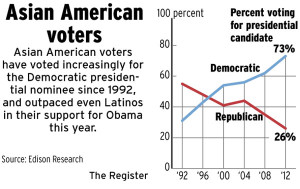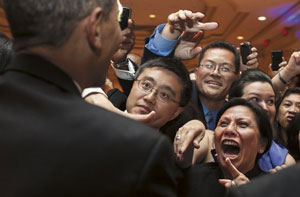Asian American Votes Up For Grabs In Political Parties

By D.A. Barber.
According to the May 8 Census report, Asians who voted between 2008-2012 rose by about 550,000, but a large majority of Asian American votes are up for grabs.
In fact, between 1996 and 2012, “the Black population, the Asian population, and the Hispanic population all saw their shares of the eligible electorate and the voting population increase. Non-Hispanic whites were the only race group whose shares of the eligible electorate and the voting population did not increase,” according to the report.
A survey released in April illustrated that Asian Americans and Pacific Islanders – “open to persuasion” by either major party at the ballot box are two of the fastest-growing demographics in the U.S., according to by the Asian American Justice Center (AAJC,) Asian and Pacific Islander American Vote (APIAVote,) and National Asian American Survey (NAAS).
Among the survey findings: Two-thirds of Asian Americans and Pacific Islanders voted for President Obama, yet about half are actually independent or do not think in terms of a political party, so those Asian American votes are up for grabs in upcoming elections.
“Our research shows that if either major party made significant investments to engage with Asian American and Pacific Islander voters, they could reap significant advantages over the next decade,” said Karthick Ramakrishnan, director of NAAS. ”This is especially the case as Asian Americans and Pacific Islanders have a sizable portion of persuadable voters.”
An earlier poll taken election 2012 eve, found 49 percent of Asian Americans identified as Democrats, 34 percent identified as Republican, and 17 percent identified as independent.This new survey – conducted in nine Asian languages – found that national polls conducted only in English might have “underestimated the vote share for Mitt Romney.”
“The parties and other voter mobilizing organizations must invest in linguistically and culturally appropriate outreach to engage our communities for future elections,” said Christine Chen, executive director of APIAVote.
Asian Americans and Pacific Islanders makes up about 4.8 percent of the U.S. population, but they comprised only 3 percent of U.S. voters in 2012, that number increased 128 percent from 1996 to 2008. That is bound to change.

Studies show political strategists on both sides of the aisle agree that the Asian community remains persuadable by either party. And even in late September 2012, President Obama had 43 percent of the Asian American community, compared to 24 percent favoring Mitt Romney. In this photo, President Obama speaks to an increasingly powerful Asian American demographic last May. Photo Credit: Official White House Photo/Pete Souza
New population projections released May 15 by the Census Bureau show the U.S. will become a “majority-minority” by 2041, and no later than 2046. The Census also notes that the population under 18 years will be majority-minority by 2018 or 2019 – as will the working-age population (18-64) between 2036 and 2042.
The Census projects a constant level of net migration of 725,000 throughout 2012-2060, meaning that the Asian population, 5.1 percent of the total in 2012, would reach 7.3 percent in 2060 in the low projections and 9 percent in the high scenario. That compares to the Hispanic population – 17 percent of the total in 2012 – projected to reach between 29.9 and 31.3 percent by 2060.
“This projected milestone reflects the mix of our nation’s declining fertility rates, the aging of the baby boomer population and continued immigration,” said Thomas Mesenbourg, the Census Bureau’s senior adviser.
Featured Photo Credit: nationaljournal.com
